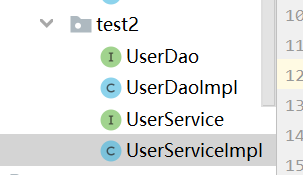使用XML配置实现Bean
1.创建一个Maven项目
在Maven中导入我们需要的Spring
注 : spring 需要导入commons-logging进行日志记录 . 我们利用maven , 他会自动下载对应的依赖项 .
<dependency>
<groupId>org.springframework</groupId>
<artifactId>spring-webmvc</artifactId>
<version>5.1.10.RELEASE</version>
</dependency>
为了测试需要再导入一个junit测试包
<dependency>
<!-- junit测试包-->
<groupId>junit</groupId>
<artifactId>junit</artifactId>
<version>4.12</version>
</dependency>
2.编写一个实体类,给属性set方法
package com.lei.test1;
public class Book {
//创建Bookd的属性
private String bname;
private String bauthor;
//set方法
public void setBname(String bname) {
this.bname = bname;
}
public void setBauthor(String bauthor) {
this.bauthor = bauthor;
}
@Override
public String toString() {
return "Book{" +
"bname='" + bname + '\'' +
", bauthor='" + bauthor + '\'' +
'}';
}
// public static void main(String[] args) {
// Book book=new Book();
// book.setBname("水浒传");
// }//这是原始方法,我们先注释掉
}
3.编写我们的spring,xml文件 , 这里我们命名为beans.xml

beans.xml添加如下
<?xml version="1.0" encoding="UTF-8"?>
<beans xmlns="http://www.springframework.org/schema/beans"
xmlns:xsi="http://www.w3.org/2001/XMLSchema-instance"
xsi:schemaLocation="http://www.springframework.org/schema/beans http://www.springframework.org/schema/beans/spring-beans.xsd">
<!--配置Book对象创建,使用bean标签,标签例添加对应属性,
id,唯一标识 class,类全路径
<bean id="book" class="com.lei.test1.Book">完成对象创建
bean就是java对象 , 由Spring创建和管理
在实体类中set方法后,使用property标签完成对象属性的注入
name:对象里属性名称 value:注入的值
-->
<bean id="book" class="com.lei.test1.Book">
<property name="bname" value="红楼梦"></property>
<property name="bauthor" value="曹雪芹"></property>
</bean>
</beans>
4.去测试类下
package com.lei.test;
import com.lei.test1.Book;
import org.junit.Test;
import org.springframework.context.ApplicationContext;
import org.springframework.context.support.ClassPathXmlApplicationContext;
public class testBook {
@Test
public void addBook(){
//加载Spring配置文件
ApplicationContext context = new ClassPathXmlApplicationContext("beans.xml");
//getBean : 参数即为spring配置文件中bean的id .
Book book = context.getBean("book",Book.class);
System.out.println(book);
}
}
>结果

> 思考 ??
对象是谁创建的 ? 【hello 对象是由Spring创建的
对象的属性是怎么设置的 ? hello 对象的属性是由Spring容器设置的
这个过程就叫控制反转 :
控制 : 谁来控制对象的创建 , 传统应用程序的对象是由程序本身控制创建的 , 使用Spring后 , 对象是由Spring来创建的
反转 : 程序本身不创建对象 , 而变成被动的接收对象 .
依赖注入 : 就是利用set方法来进行注入的,接下来会写一个注释进行注入的案例
IOC是一种编程思想,由主动的编程变成被动的接收
注意点1:构造器问题
属性注入时,默认是空构造器注入,有参构造器时呢?,更改Spring.xml文件,改变如下

延伸点2:
p名称空间注入
添加p名称空间到配置中
xmlns:p="http://www.springframework.org/schema/p"
整体
<?xml version="1.0" encoding="UTF-8"?>
<beans xmlns="http://www.springframework.org/schema/beans"
xmlns:xsi="http://www.w3.org/2001/XMLSchema-instance"
xmlns:p="http://www.springframework.org/schema/p"
xsi:schemaLocation="http://www.springframework.org/schema/beans http://www.springframework.org/schema/beans/spring-beans.xsd">
<bean id="book" class="com.lei.test1.Book"
p:bname="斗破苍穹" p:bauthor="天蚕土豆">
</bean>
</beans>

总结:通过对比–p名称空间最大的作用就是简化操作,当注入的属性过多时使用p名称空间是个不错的选择
延伸点3:注入null值和特殊符号

了解更多可以度娘哟!!!
延伸点4:外部bean的注入
案例为我们经常写的Dao和Service层

1.编写这些代码
package com.lei.test2;
public interface UserDao {
public void adddate();
}
package com.lei.test2;
public class UserDaoImpl implements UserDao {
public void adddate() {
System.out.println("UserDao add...");
}
}
package com.lei.test2;
public interface UserService {
}
package com.lei.test2;
public class UserServiceImpl implements UserService {
public void add(){
System.out.println("service add...");
userDao.adddate();
//原始方法---我们使用Spring的IOC实现,所以先注释掉
// UserDao userDao=new UserDaoImpl();
// userDao.adddate();
}
//将外部对象当做属性
private UserDao userDao;
//给外部对象set方法
public void setUserDao(UserDao userDao){
this.userDao=userDao;
}
}
2.Spring.xml配置文件
<?xml version="1.0" encoding="UTF-8"?>
<beans xmlns="http://www.springframework.org/schema/beans"
xmlns:xsi="http://www.w3.org/2001/XMLSchema-instance"
xsi:schemaLocation="http://www.springframework.org/schema/beans http://www.springframework.org/schema/beans/spring-beans.xsd">
<bean id="userDaoImpl" class="com.lei.test2.UserDaoImpl"></bean>
<bean id="userServiceImpl" class="com.lei.test2.UserServiceImpl">
<property name="userDao" ref="userDaoImpl"></property>
</bean>
</beans>
3.测试:
@Test
public void testUser(){
//加载Spring配置文件
ApplicationContext context = new ClassPathXmlApplicationContext("beans.xml");
//getBean : 参数即为spring配置文件中bean的id .
UserServiceImpl userServiceImpl=context.getBean("userServiceImpl",UserServiceImpl.class);
userServiceImpl.add();
}
4.结果

延伸点5:内部bean的注入和级联赋值



Test同上,一,加载配置文件,二:获取配置对象
延伸点6:注入集合属性
1.创建对象类
package com.lei.test3;
import java.util.Arrays;
import java.util.List;
import java.util.Map;
import java.util.Set;
public class Stu {
private String[] courses;
private List<String> list;
private Map<String,String> maps;
private Set<String> sets;
public void setCourses(String[] courses) {
this.courses = courses;
}
public void setList(List<String> list) {
this.list = list;
}
public void setMap(Map<String, String> maps) {
this.maps = maps;
}
public void setSets(Set<String> sets) {
this.sets = sets;
}
public void test(){
System.out.println(Arrays.toString(courses));
System.out.println(list);
System.out.println(maps);
System.out.println(sets);
}
}
2.编写Spring.xml文件
<?xml version="1.0" encoding="UTF-8"?>
<beans xmlns="http://www.springframework.org/schema/beans"
xmlns:xsi="http://www.w3.org/2001/XMLSchema-instance"
xmlns:p="http://www.springframework.org/schema/p"
xsi:schemaLocation="http://www.springframework.org/schema/beans http://www.springframework.org/schema/beans/spring-beans.xsd">
<bean id="stu" class="com.lei.test3.Stu">
<!-- 数组类型属性注入-->
<property name="courses">
<array>
<value>数据库</value>
<value>数据结构</value>
</array>
</property>
<!-- list类型属性注入-->
<property name="list">
<list>
<value>张松</value>
<value>雷某</value>
</list>
</property>
<!-- map类型属性注入-->
<property name="map">
<map>
<entry key="Java" value="java"></entry>
<entry key="PHP" value="php"></entry>
</map>
</property>
<!-- set类型属性注入-->
<property name="sets">
<set>
<value>hadoop</value>
<value>spark</value>
</set>
</property>
</bean>
</beans>
3.测试类
@Test
public void testCollecton(){
//加载Spring配置文件
ApplicationContext context =
new ClassPathXmlApplicationContext("beans.xml");
//getBean
Stu stu=context.getBean("stu",Stu.class);
stu.test();
}
结果

注:集合里面设置对象为属性???
1.新建一个类
package com.lei.test3;
public class Course {
private String cname;
public void setCname(String cname) {
this.cname = cname;
}
@Override
public String toString() {
return "Course{" +
"cname='" + cname + '\'' +
'}';
}
}
2.在Stu中写入
import java.util.List;
public class Stu {
private List<Course> courseList;
public void setCourseList(List<Course> courseList) {
this.courseList = courseList;
}
public void test(){
System.out.println(courseList);
}
}
3.在Spring.xml中写入
<?xml version="1.0" encoding="UTF-8"?>
<beans xmlns="http://www.springframework.org/schema/beans"
xmlns:xsi="http://www.w3.org/2001/XMLSchema-instance"
xmlns:p="http://www.springframework.org/schema/p"
xsi:schemaLocation="http://www.springframework.org/schema/beans http://www.springframework.org/schema/beans/spring-beans.xsd">
<bean id="course1" class="com.lei.test3.Course">
<property name="cname" value="xiaoxiao"></property>
</bean>
<bean id="course2" class="com.lei.test3.Course">
<property name="cname" value="dada"></property>
</bean>
<bean id="stu" class="com.lei.test3.Stu">
<property name="courseList">
<list>
<ref bean="course1"></ref>
<ref bean="course2"></ref>
</list>
</property>
</bean>
</beans>
4.测试类,
@Test
public void testCollecton(){
//加载Spring配置文件
ApplicationContext context =
new ClassPathXmlApplicationContext("beans.xml");
//getBean
Stu stu=context.getBean("stu",Stu.class);
stu.test();
}
5.结果:

延伸点7:IOC操作Bean管理----工厂bean
Spring 中有两种Bean,一种普通bean,一种工厂bean(FactoryBean)
普通bean:在配置文件中定义类型和返回类型一致
工厂bean:在配置文件中定义类型和返回类型不一致
使用注解方式实现Bean
点击下一章哟!!!!






















 289
289











 被折叠的 条评论
为什么被折叠?
被折叠的 条评论
为什么被折叠?








